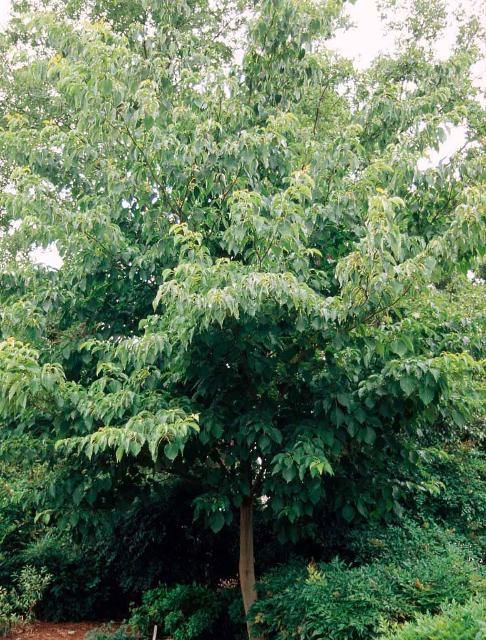Introduction
Giant dogwood, a fast-growing deciduous tree that reaches 30 to 50 feet in height, eventually displays attractive horizontal branches clothed in large, 5- to 8-inch long leaves, dark green above and silver/green beneath, which turn a lovely red color in the fall. In the middle of springtime, the trees produce a multitude of flat, white clusters of bloom in dense cymes up to 5-inches across. These blooms are followed by showy, blue/black berries which are quite attractive to birds and other wildlife. The branching pattern is more upright in youth, spreading as it grows.

Credit: Ed Gilman, UF/IFAS
General Information
Scientific name: Cornus controversa
Pronunciation: KOR-nus kawn-troe-VER-suh
Common name(s): Giant dogwood
Family: Cornaceae
USDA hardiness zones: 5A through 8A (Fig. 2)
Origin: not native to North America
Invasive potential: little invasive potential
Uses: deck or patio; shade; street without sidewalk; tree lawn 3–4 feet wide; tree lawn 4–6 feet wide; tree lawn > 6 ft wide; specimen; shade
Availability: not native to North America

Description
Height: 30 to 50 feet
Spread: 25 to 35 feet
Crown uniformity: symmetrical
Crown shape: upright/erect, spreading
Crown density: moderate
Growth rate: fast
Texture: medium
Foliage
Leaf arrangement: opposite/subopposite (Fig. 3)
Leaf type: simple
Leaf margin: entire
Leaf shape: ovate
Leaf venation: pinnate, brachidodrome
Leaf type and persistence: deciduous
Leaf blade length: 4 to 8 inches
Leaf color: green
Fall color: red
Fall characteristic: showy

Flower
Flower color: white/cream/gray
Flower characteristics: showy
Fruit
Fruit shape: round
Fruit length: less than .5 inch
Fruit covering: fleshy
Fruit color: blue, black
Fruit characteristics: attracts birds; showy; fruit/leaves not a litter problem
Trunk and Branches
Trunk/bark/branches: branches droop; not showy; typically one trunk; thorns
Pruning requirement: needed for strong structure
Breakage: resistant
Current year twig color: green
Current year twig thickness: medium
Wood specific gravity: unknown
Culture
Light requirement: full sun, partial sun, or partial shade
Soil tolerances: clay; sand; loam; acidic; well-drained
Drought tolerance: moderate
Aerosol salt tolerance: unknown
Other
Roots: not a problem
Winter interest: no
Outstanding tree: no
Ozone sensitivity: unknown
Verticillium wilt susceptibility: resistant
Pest resistance: resistant to pests/diseases
Use and Management
Giant dogwood should be grown in full sun for best flowering on moist, well-drained, acid soil. Used most often as a patio or medium-sized shade tree, giant dogwood has been planted as a street tree in some communities and may be considered more tolerant of urban soil than other dogwoods. It has been the fastest growing dogwood at the North Carolina State Arboretum.
The cultivar 'Variegata' has narrow, yellow-edged leaves but is rare in cultivation.
Propagation is by cuttings with ease or seeds with difficulty.
Pests
No pests are of major concern.
Diseases
Leaf spot, twig blight, or canker.
